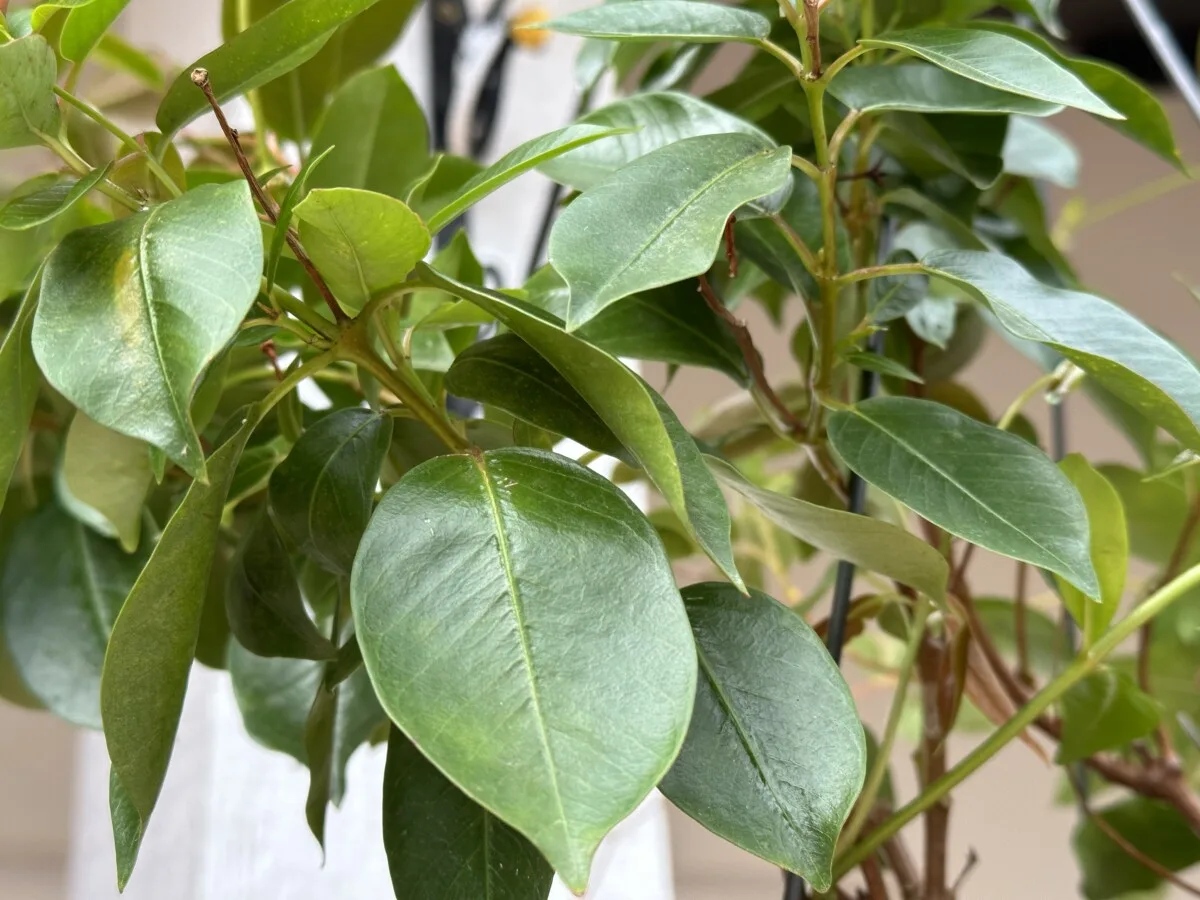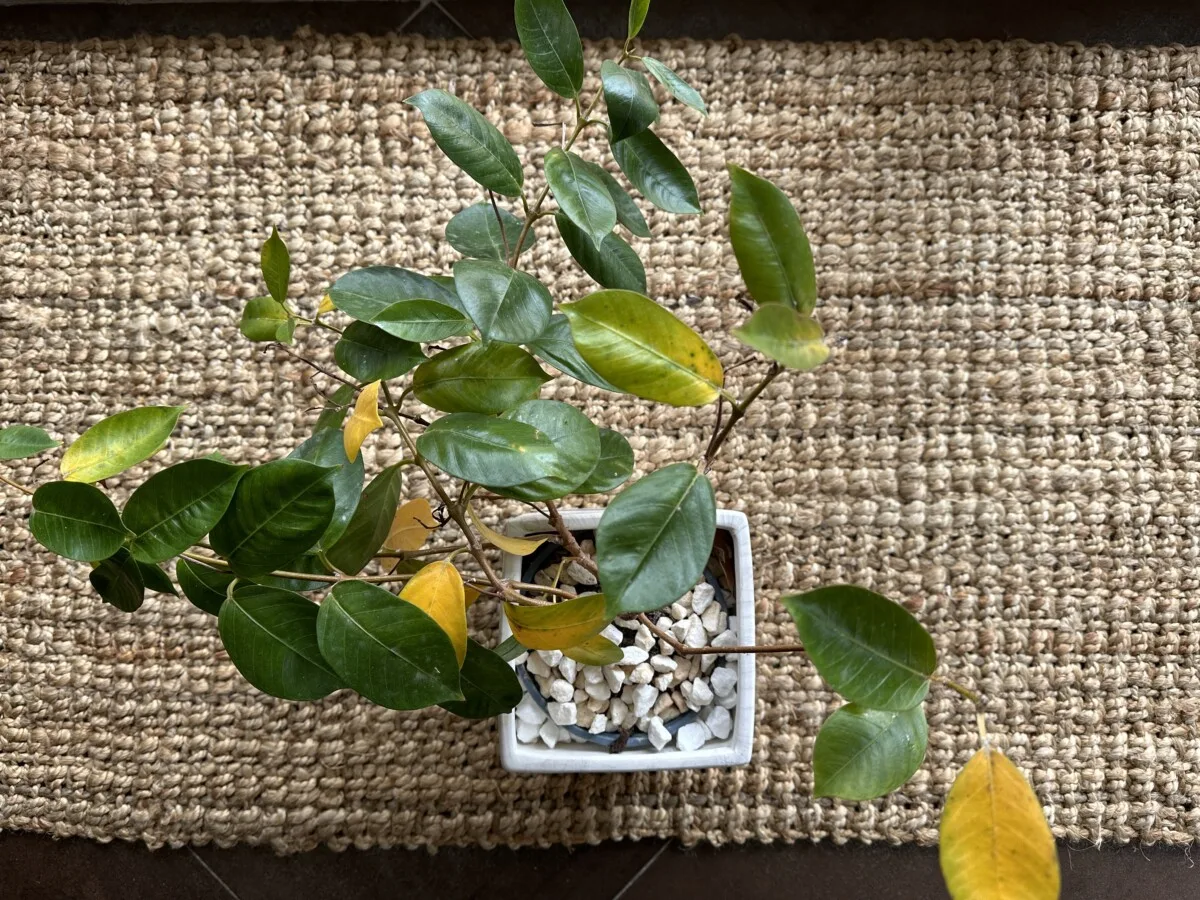
Dipladenias are full of surprises.
To begin with they masquerade under different names. You might know them as Rocktrumpets or as Mandevillas. Although dipladenias are bushier than the vining mandevillas, they belong to the same family and most garden stores use the names interchangeably. Here in France, they lump them together by calling them all Dipladenia Mandevillas.

Dipladenia are tropical plants hailing from Central and South America, but they seem quite at home in the Northern Hemisphere on a summer day.
The first time I purchased one for my home in Toulouse, I couldn’t believe how it outperformed my annuals. I never fertilized or pruned it, and it bloomed profusely all summer long.

However, during a period of three days in September, the magic ran out. It went from being the beautiful swan to being the ugly duckling. I brought it indoors to examine it. Thinking it might be diseased, I stuck it on a shelf in the laundry room away from my house plants and then promptly forgot about it for a week. When I finally remembered it, I was astonished to discover it was far from dead. In fact, it had produced new flower buds!
Why was that? Over the five years following the laundry room discovery, I’ve learned that dipladenias are remarkable plants that have a few tricks up their sleeves. The following are six things I believe all dipladenia (mandevilla) owners need to know:
1. Swan to Ugly Duckling

First, considering their origins, it makes sense that dipladenias (mandevillas) are only sold as perennials in Zone 9 and up. They thrive in temperatures from 60-85°F (15-29°C) and are highly-sensitive to temperatures below that.
Although far from being cold, our nighttime temperatures in Zone 8 Southwestern France drop at the beginning of September. The return to school in the first week of September signifies daytime temperatures similar to July but mornings as chilly as April.
This drop in temperature is why my dipladenia turned into an ugly duckling that first year. The cooler nights were killing it, and a night at 50°F (10°C) is to a dipladenia mandevilla as a light frost is to most annuals.
Trying to outsmart Mother Nature, last year I placed one dipladenia against a wall where it would be protected from wind and could benefit from ambient heat coming from the sunny wall. I’ve had success using this trick to keep plants alive in winter that are otherwise not hardy in our zone. This time, however, it did not work. In fact, the plant began dying as soon as the cooler nights of September arrived, and when death comes to a mandevilla, it comes quickly.

2. Dipladenias Are A Creature of Comfort

Dipladenias are creatures of comfort. Although they are sold as annuals where I live, they can easily ride out our chilly winters indoors.
The dipladenia that took up residence in my laundry room that first fall & winter is still alive today. It lives like we do, spending its summers outdoors on the patio and its winters tucked inside catching rays of sun when they break through the fog.
As you might have already guessed, dipladenia mandevillas should be moved inside before nighttime temperatures dip below 60°F (15°C).
This past winter my indoor dipladenia put on a spectacular show of blooms at the end of November. The key is to find a sunny room, and your dipladenia mandevilla will reward you for it.

3. Not a Drinker

Dipladenias are not big drinkers. While they enjoy consistent watering, they can tolerate moderate droughts. I water mine once a week unless the daily temperatures exceed 95°F (35°C) degrees.
The key is to allow the top two inches of soil to dry out completely before watering and to water thoroughly at that time.
Overwatering and constantly damp soil can result in root or disease. Just remember, dipladenia mandevillas like to drink in moderation.
4. Enjoys a Spa Day
A dipladenia mandevilla isn’t demanding, so you might not notice the first signs of stress. One year I overwintered a plant in my kitchen. The kitchen received the perfect amount of morning sun and was cozy. In January, the leaves of the plant turned yellow and dropped in the span of a week. I was baffled until I thought back to the first dipladenia and its stay in the laundry room.

The difference between the two environments was obvious. Both were cozy and warm, but the kitchen offered a dry heat. That January had been cold, so our radiators had been running constantly. The laundry room, on the other hand, offered a humid heat, probably not unlike the plant’s tropical origins. Lesson learned.
Now in the winter, I keep my dipladenia mandevillas in a room where the air is less dry. I also rotate them through the laundry room during the worst months of winter, because although they don’t demand it, they do enjoy a spa day.
5. Sunburns Easily

Dipladenias sunburn easily. This seems counterintuitive for a tropical, heat-loving plant, so many mandevilla owners have scorched their plants unintentionally. I admit that this was one of my mistakes early on.
As I mentioned earlier, my first mandevilla sailed through summer like it was untouchable. It was in a hanging basket on our patio. The following year, I put it on the same patio where it had spent its first magnificent summer. This time, however, I hung it in a different place, and that made a world of difference.

Although overall the plant was green and healthy, one side of the plant developed brown leaves. That’s when I notice the movement of the sun across our patio meant direct sunrays hit that side of the plant in the afternoon.
The key for dipladenias is to put them in a place with full (at least 6 hours) indirect sunlight or direct morning sunlight. Without knowing it, the location I chose in my dipladenia’s first year had been ideal. Due to an awning over our outdoor eating area, the dipladenia mandevilla had enjoyed a summer in full, indirect sun. Now I place my dipladenias in locations around my patios that let them sunbathe without getting sunburnt!
6. Attractive to Man and Beasts

From their glossy leaves to their vibrant, trumpet-shaped flowers, dipladenias are beautiful plants. Unfortunately, we aren’t the only living things attracted to them.
If you are a new dipladenia (mandevilla) owner, be sure to watch out for ants on the fresh, tender buds and vines. Ants farm aphids on many plants, dipladenias included. If you notice ants around your plant, check for aphids and treat them immediately.
Despite their preferences for specific conditions and treatments, dipladenias are not fussy plants. If you make a few allowances for them, you will be rewarded with gorgeous plants that offer you spectacular blooms even in the depths of winter.
I’ve been a dipladenia mandevilla owner for five years now, and as I add to my collection each year, I continue to be surprised by how much they give for so little.
